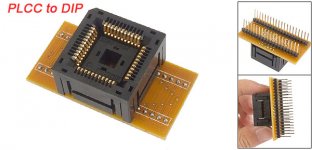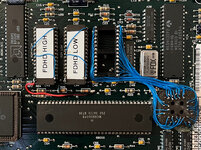gogopuffs
Well-known member

See that adapter? Think about it as a little bit of inspiration.
So, the SWIM chip as we all know is an upgrade to earlier Macintosh SE machines that were equipped with 800k drives and was once an upgrade option for users who want to read and write 1.44MB floppy drives.
I'm now an owner of a battery-acid-victim SE/30 motherboard and was wondering about what could be used as a donor for other systems. I am also in possession of an 800k Macintosh SE overseas and was just fantasizing about using the SWIM chip and SuperDrive from the SE/30 in the SE.
First problem: form factor. The IWM and SWIM chip in the Macintosh SE is the 28 pin DIP package. Yeah, good enough. Too bad that the SE/30 SWIM form factor comes in a 44-pin PLCC form factor. (square package with pins on all sides vs. rectangle package with pins only length-wise)
So, looking a little deeper at the documentation referenced below, it seems they are work-alikes, they just need to be wired up properly.
And possibly it may mean that I need to do a bit of board design to get the right pinouts. This is new territory for me, but nothing's impossible, right?
So then the living Mac SE gets the SWIM chip in the bespoke cradle in a DIP package, the SuperDrive from the donated SE/30, and a whole new era of parts salvage possibilities comes about. This feels easier than, say, trying to emulate the behavior of a SWIM chip in a programmable package (using a Teensy or similar that's more powerful than the Mac SE itself.. ha!)
Assuming the board pinouts were routed appropriately and the thing actually works, I'd imagine this would be useful for people doing resto-mods and retro-upgrades to their Macintosh SE machines. Donor boards for SWIM chips wouldn't be limited to just SE/30's, they could come from Classic logic boards, IIci boards, etc.
References:
http://mirror.informatimago.com/next/developer.apple.com/technotes/hw/pdf/hw_14.pdf Apple Technical Note HW14
<a data-ipb="nomediaparse" data-cke-saved-href="http://ftp.netbsd.org/pub/NetBSD/misc/wrstuden/Apple_PDFs/SWIM%20Chip%20User"href="http://ftp.netbsd.org/pub/NetBSD/misc/wrstuden/Apple_PDFs/SWIM%20Chip%20User" s%20ref.pdf"="">http://ftp.netbsd.org/pub/NetBSD/misc/wrstuden/Apple_PDFs/SWIM%20Chip%20User's%20Ref.pdf Apple SWIM Chip Reference Guide
http://www.ccadams.org/se/MacSEservice.pdf Mac SE Service Guide
Mods - feel free to move this message into a different forum if it's not appropriate - hardware hacks? I dunno.
Last edited by a moderator:


